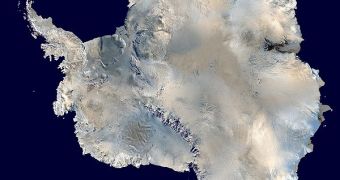In the first large-scale study to ever prove so, experts at the Cardiff University, in the United Kingdom, determined that the decline in CO2 levels in the planet's atmosphere some 34 million years ago led to the formation of the ice caps in Antarctica. Scientists from the University of Bristol and the Texas A&M University, in the United States, were also involved in the new study, e! Science News reports. Planetary scientists have believed for a long time that the Antarctic ices appeared as a result of a gradually diminishing greenhouse effect, and this is the first major scientific work to prove this.
The new paper, published online ahead of print in the respected scientific journal Nature, cites geological records that show ice formation in the Antarctic began when CO2 concentrations in the planet's atmosphere reached a tipping point by volume of around 760 parts per million. This shift was recorded during the Eocene-Oligocene climate transition. The find was made by analyzing microfossils extracted from rocks at a dig site in a small East-African village. The records painted an image of CO2 levels during those distant times.
“About 34 million years ago the Earth experienced a mysterious cooling trend. Glaciers and small ice sheets developed in Antarctica, sea levels fell and temperate forests began to displace tropical-type vegetation in many areas. The period, known to geologists as the Eocene-Oligocene transition, culminated in the rapid development of a continental-scale ice sheet on Antarctica, which has been there ever since. We therefore set out to establish whether there was a substantial decline in atmospheric carbon dioxide levels as the Antarctic ice sheet began to grow,” CU School of Earth and Ocean Sciences expert, Professor Paul Pearson, the leader of the African expedition, explains.
Hundreds of meters of rock samples were extracted from specifically designated points near the East-African village of Stakishari. A full-scale drilling rig was set up to extract the needed samples. The layers that were being explored needed to be of the exact age the scientists were looking to analyze, and a large map of underground deposits was drawn out first, through trial-and-error digs.
“By using the rather unique set of samples from Tanzania and a new analytical technique that I developed, we have, for the first time, been able to reconstruct the concentration of CO2 across the Eocene-Oligocene boundary – the time period about 34 million years ago when ice sheets first started to grow on Eastern Antarctica,” University of Bristol Earth Sciences Department expert Dr. Gavin Foster, the co-author of the new paper, says.
“This was the biggest climate switch since the extinction of the dinosaurs 65 million years ago. Our study is the first to provide a direct link between the establishment of an ice sheet on Antarctica and atmospheric carbon dioxide levels and therefore confirms the relationship between carbon dioxide levels in the atmosphere and global climate,” Texas A&M University Department of Geology and Geophysics scientist Dr. Bridget Wade, also a co-author of the Nature study, concludes.

 14 DAY TRIAL //
14 DAY TRIAL //